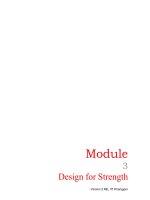Tài liệu Fundamentals of Machine Design P10 docx
Bạn đang xem bản rút gọn của tài liệu. Xem và tải ngay bản đầy đủ của tài liệu tại đây (538.34 KB, 14 trang )
Version 2 ME, IIT Kharagpur
Module
3
Design for Strength
Version 2 ME, IIT Kharagpur
Lesson
4
Low and high cycle fatigue
Version 2 ME, IIT Kharagpur
Instructional Objectives
At the end of this lesson, the students should be able to understand
• Design of components subjected to low cycle fatigue; concept and necessary
formulations.
• Design of components subjected to high cycle fatigue loading with finite life;
concept and necessary formulations.
• Fatigue strength formulations; Gerber, Goodman and Soderberg equations.
3.4.1 Low cycle fatigue
This is mainly applicable for short-lived devices where very large overloads may
occur at low cycles. Typical examples include the elements of control systems in
mechanical devices. A fatigue failure mostly begins at a local discontinuity and
when the stress at the discontinuity exceeds elastic limit there is plastic strain.
The cyclic plastic strain is responsible for crack propagation and fracture.
Experiments have been carried out with reversed loading and the true stress-
strain hysteresis loops are shown in figure-3.4.1.1. Due to cyclic strain the
elastic limit increases for annealed steel and decreases for cold drawn steel. Low
cycle fatigue is investigated in terms of cyclic strain. For this purpose we consider
a typical plot of strain amplitude versus number of stress reversals to fail for steel
as shown in figure-3.4.1.2.
Version 2 ME, IIT Kharagpur
3.4.1.1F- A typical stress-strain plot with a number of stress reversals (Ref.[4]).
Here the stress range is Δσ. Δε
p
and Δε
e
are the plastic and elastic strain ranges,
the total strain range being Δε. Considering that the total strain amplitude can be
given as
pe
Δε Δε Δε= +
A relationship between strain and a number of stress reversals can be given as
'
a' b
f
f
σ
Δε (N) ε (N)
E
=+
where
σ
f
and
ε
f
are the true stress and strain corresponding to fracture in one
cycle and a, b are systems constants. The equations have been simplified as
follows:
p
u
N
EN
0.6
0.12
3.5
ε
⎛⎞
σ
Δε = +
⎜⎟
⎝⎠
Version 2 ME, IIT Kharagpur
In this form the equation can be readily used since
σ
u
,
ε
p
and E can be measured
in a typical tensile test. However, in the presence of notches and cracks
determination of total strain is difficult.
3.4.1.2F- Plots of strain amplitude vs number of stress reversals for
failure.
3.4.2 High cycle fatigue with finite life
This applies to most commonly used machine parts and this can be analyzed by
idealizing the S-N curve for, say, steel, as shown in figure- 3.4.2.1 .
The line between 10
3
and 10
6
cycles is taken to represent high cycle fatigue with
finite life and this can be given by
Sb Nc= +log log
where S is the reversed stress and b and c are constants.
At point A
()
u
b c
3
log 0.8 log10
σ= +
where
σ
u
is the ultimate tensile stress
and at point B
e
b cσ= +
6
log log10
where
σ
e
is the endurance limit.
T
o
t
a
l
st
r
a
i
n
E
l
a
s
tic
s
tr
a
i
n
P
l
a
s
t
ic
st
r
a
in
c
b
10
1
10
2
10
3
10
4
10
5
10
6
10
-3
10
-2
10
-1
1
Number of stress reversals for failure, N
Strain amplitude,
'
f
E
σ
10
0
1
1
Δε









